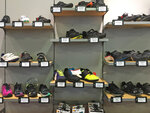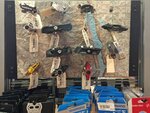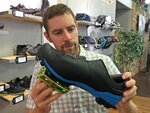Hi guys! I'm moving some content off of the main site and into the most relevant categories of the forum. This post was originally made on December 23rd 2016:
For the longest time I was confused about the term “clipless” as it relates to bicycle pedals. Why are they called clip-less if they utilize a clipping mechanism to hold your shoe in place? As it turns out, the word clipless was first associated with baskets and cages used to completely secure the foot of Tour de France racers in the early days of the sport. After years of development, a wide range of springs and connectors emerged to replace cages along with stiffer shoes utilizing advanced plastic molding and eve carbon fiber. So today, we’re stuck with a somewhat confusing verbal landscape but reap the benefits of a much more versatile solution, a whole landscape of shoes and pedals designed for mountain biking, road cycling, racing, a bit of performance and a bit of walking… or the old-fashioned platform pedals that work without any connection and instead rely on metal nubs and sticky rubber soles.
This topic is huge, it’s not something I’m prepared to cover in detail with a single guide but my friend Erik from Peloton Cycles in Fort Collins, CO did a pretty good job in the video below. I was in the process of buying a Specialized Turbo Levo electric mountain bike and asked him about bicycle shoes. What you see below is our freestyle conversation which includes a bit of history, some of the pros and cons of each pedal and shoe type and a bit of pricing background.
As someone who now owns clipless “clip-in” pedals, and uses them regularly with an electric mountain bike… my feelings are mixed. They cost a lot of money up front but are expected to last. They raise the height of my pedal strokes and allow for fewer snags while turning (because the pedal and shoe are less bulky than platform pedals). But I have also come out of the pedal on several occasions while riding. Ebikes tend to weigh more and that weight develops its own momentum. I can’t toss the bike around or bunny hop as easily as with a normal human-powered mountain bike. At times where I’ve been turning hard and pushing down with my outside pedal, I’ve popped out and nearly fallen. At other times when using my legs to lift the bike (while jumping or hopping) the pedals have held my body down and kept me from flying off the bike.




Ultimately, I’ve transitioned back to wide, grippy platform pedals like these and choose to pedal with my every day tennis shoes. This allows me to easily hop off the bike and walk around comfortably, commute to work without carrying extra “normal” shoes and allow friends and curious strangers to try my electric bike without slipping on tiny clipless pedals. I still have my nicer shoes and may try them out on a road style ebike someday or one that I plan to use mostly in urban environments. As for off-road riding, I just couldn’t stomach more unplanned disconnects and potential falls. Yes, I drag my platform pedals more frequently and have scraped my shins continuously on the metal pins but they perform more consistently. Perhaps a different clipless interface would work better for me but I’m not ready to spend the money to find out and be disappointed. I hope my experience helps you out and I welcome feedback because shoes and pedals are very personal. For me the power and speed of ebike motor and battery systems more than makes up for a slightly less stiff pedal and shoe. I’d rather have comfort and as Erik said in the video; if your contact points are comfortable (hands, sit bones and feet) you won’t usually ride as much.
For the longest time I was confused about the term “clipless” as it relates to bicycle pedals. Why are they called clip-less if they utilize a clipping mechanism to hold your shoe in place? As it turns out, the word clipless was first associated with baskets and cages used to completely secure the foot of Tour de France racers in the early days of the sport. After years of development, a wide range of springs and connectors emerged to replace cages along with stiffer shoes utilizing advanced plastic molding and eve carbon fiber. So today, we’re stuck with a somewhat confusing verbal landscape but reap the benefits of a much more versatile solution, a whole landscape of shoes and pedals designed for mountain biking, road cycling, racing, a bit of performance and a bit of walking… or the old-fashioned platform pedals that work without any connection and instead rely on metal nubs and sticky rubber soles.
This topic is huge, it’s not something I’m prepared to cover in detail with a single guide but my friend Erik from Peloton Cycles in Fort Collins, CO did a pretty good job in the video below. I was in the process of buying a Specialized Turbo Levo electric mountain bike and asked him about bicycle shoes. What you see below is our freestyle conversation which includes a bit of history, some of the pros and cons of each pedal and shoe type and a bit of pricing background.
As someone who now owns clipless “clip-in” pedals, and uses them regularly with an electric mountain bike… my feelings are mixed. They cost a lot of money up front but are expected to last. They raise the height of my pedal strokes and allow for fewer snags while turning (because the pedal and shoe are less bulky than platform pedals). But I have also come out of the pedal on several occasions while riding. Ebikes tend to weigh more and that weight develops its own momentum. I can’t toss the bike around or bunny hop as easily as with a normal human-powered mountain bike. At times where I’ve been turning hard and pushing down with my outside pedal, I’ve popped out and nearly fallen. At other times when using my legs to lift the bike (while jumping or hopping) the pedals have held my body down and kept me from flying off the bike.




Ultimately, I’ve transitioned back to wide, grippy platform pedals like these and choose to pedal with my every day tennis shoes. This allows me to easily hop off the bike and walk around comfortably, commute to work without carrying extra “normal” shoes and allow friends and curious strangers to try my electric bike without slipping on tiny clipless pedals. I still have my nicer shoes and may try them out on a road style ebike someday or one that I plan to use mostly in urban environments. As for off-road riding, I just couldn’t stomach more unplanned disconnects and potential falls. Yes, I drag my platform pedals more frequently and have scraped my shins continuously on the metal pins but they perform more consistently. Perhaps a different clipless interface would work better for me but I’m not ready to spend the money to find out and be disappointed. I hope my experience helps you out and I welcome feedback because shoes and pedals are very personal. For me the power and speed of ebike motor and battery systems more than makes up for a slightly less stiff pedal and shoe. I’d rather have comfort and as Erik said in the video; if your contact points are comfortable (hands, sit bones and feet) you won’t usually ride as much.

